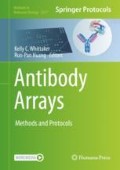Abstract
Dried blood samples have been increasingly considered for clinical applications in recent years. The main disadvantages that limit DBS utility in clinical applications are the small sample volume collected, area bias and homogeneity issues, and sample preparation requirements for the necessary sensitivity and reproducibility required for clinical assessment. The recent advances in antibody array technology overcome the common disadvantages of immunoassay approaches by increasing the multiplex capabilities and decreasing the sample volume requirements as well as minimizing the expense and technical expertise required with many alternative high-density approaches like mass spectrometry.
Access this chapter
Tax calculation will be finalised at checkout
Purchases are for personal use only
References
Demirev PA (2013) Dried blood spots: analysis and applications. Anal Chem 85(2):779–789. https://doi.org/10.1021/ac303205m
Snijdewind IJ, van Kampen JJ, Fraaij PL, van der Ende ME, Osterhaus AD, Gruters RA (2012) Current and future applications of dried blood spots in viral disease management. Antivir Res 93(3):309–321. https://doi.org/10.1016/j.antiviral.2011.12.011
Barfield M, Spooner N, Lad R, Parry S, Fowles S (2008) Application of dried blood spots combined with HPLC-MS/MS for the quantification of acetaminophen in toxicokinetic studies. J Chromatogr B Anal Technol Biomed Life Sci 870(1):32–37. https://doi.org/10.1016/j.jchromb.2008.05.025
Versace F, Déglon J, Lauer E, Mangin P, Staub C (2013) Automated DBS extraction prior to HILIC/RP LC–MS/MS target screening of drugs. Chromatographia 76(19–20):1281–1293
Xu Y, Woolf EJ, Agrawal NG, Kothare P, Pucci V, Bateman KP (2013) Merck’s perspective on the implementation of dried blood spot technology in clinical drug development—why, when and how. Bioanalysis 5(3):341–350. https://doi.org/10.4155/bio.12.321
Downs JA, Corstjens PL, Mngara J, Lutonja P, Isingo R, Urassa M, Kornelis D, van Dam GJ (2015) Correlation of serum and dried blood spot results for quantitation of Schistosoma circulating anodic antigen: a proof of principle. Acta Trop 150:59–63. https://doi.org/10.1016/j.actatropica.2015.06.026
Kramer MS, Chalmers B, Hodnett ED, Sevkovskaya Z, Dzikovich I, Shapiro S, Collet JP, Vanilovich I, Mezen I, Ducruet T, Shishko G, Zubovich V, Mknuik D, Gluchanina E, Dombrovskiy V, Ustinovitch A, Kot T, Bogdanovich N, Ovchinikova L, Helsing E, PROBIT Study Group (Promotion of Breastfeeding Intervention Trial) (2001) Promotion of Breastfeeding Intervention Trial (PROBIT): a randomized trial in the Republic of Belarus. JAMA 285(4):413–420
Martin RM, Patel R, Oken E, Thompson J, Zinovik A, Kramer MS, Vilchuck K, Bogdanovich N, Sergeichick N, Foo Y, Gusina N (2013) Filter paper blood spot enzyme linked immunoassay for adiponectin and application in the evaluation of determinants of child insulin sensitivity. PLoS One 8(8):24–26. https://doi.org/10.1371/journal.pone.0071315
Brindle E, Fujita M, Shofer J, O’Connor KA (2010) Serum, plasma, and dried blood spot high-sensitivity C-reactive protein enzyme immunoassay for population research. J Immunol Methods 362(1-2):112–120
Wander K, Brindle E, O’Connor KA (2012) Sensitivity and specificity of C-reactive protein and α(1)-acid glycoprotein for episodes of acute infection among children in Kilimanjaro, Tanzania. Am J Hum Biol 24(4):565–568
Borte S, Janzi M, Pan-Hammarström Q, von Döbeln U, Nordvall L, Winiarski J, Fasth A, Hammarström L (2012) Placental transfer of maternally-derived IgA precludes the use of guthrie card eluates as a screening tool for primary immunodeficiency diseases. PLoS One 7(8):e43419
Kehler J, Akella N, Citerone D, Szapacs M (2011) Application of DBS for the quantitative assessment of a protein biologic using on-card digestion LC-MS/MS or immunoassay. Bioanalysis 3:2283–2290
Leuenberger N, Saugy J, Mortensen RB, Schatz PJ, Giraud S, Saugy M (2011) Methods for detection and confirmation of hematide/peginesatide in anti-doping samples. Forensic Sci Int 213(9):15
McDade TW, Williams S, Snodgrass JJ (2007) What a drop can do: dried blood spots as a minimally invasive. Demography 44(4):899–925. https://doi.org/10.1353/dem.2007.0038
Marques BLC, Brandão CU, Silva EF, Marques VA, Villela-Nogueira CA, Do Ó KMR, de Paula MT, Lewis-Ximenez LL, Lampe E, Villar LM (2012) Dried blood spot samples: Optimization of commercial EIAs for hepatitis C antibody detection and stability under different storage conditions. J Med Virol 84:1600–1607
Lin YQ, Khetarpal R, Zhang Y, Song H, Li SS (2011) Combination of ELISA and dried blood spot technique for the quantification of large molecules using exenatide as a model. J Pharmacol Toxicol Methods 64(2):124–128
Lin YQ, Zhang Y, Li C, Li L, Zhang K, Li S (2012) Evaluation of dry blood spot technique for quantification of an Anti-CD20 monoclonal antibody drug in human blood samples. J Pharmacol Toxicol Methods 65(1):44–48
Chase BA, Johnston SA, Legutki JB (2012) Evaluation of biological sample preparation for immunosignature-based diagnostics. Clin Vaccine Immunol 19(3):352–358
Kofoed K, Schneider UV, Scheel T, Andersen O, Eugen-Olsen J (2006) Development and validation of a multiplex add-on assay for sepsis biomarkers using xMAP technology. Clin Chem 52(7):1284–1293
Skogstrand K, Ekelund CK, Thorsen P, Vogel I, Jacobsson B, Nørgaard-Pedersen B, Hougaard DM (2008) Effects of blood sample handling procedures on measurable inflammatory markers in plasma, serum and dried blood spot samples. J Immunol Methods 336(1):78–84
Skogstrand K, Thorsen P, Nørgaard-Pedersen B, Schendel DE, Sørensen LC, Hougaard DM (2005) Simultaneous measurement of 25 inflammatory markers and neurotrophins in neonatal dried blood spots by immunoassay with xMAP technology. Clin Chem 51(10):1854–1866
Faucher S, Martel A, Sherring A, Ding T, Malloch L, Kim JE, Bergeron M, Sandstrom P, Mandy FF (2004) Protein bead array for the detection of HIV-1 antibodies from fresh plasma and dried-blood-spot specimens. Clin Chem 50(7):1250–1253
Jiang W, Mao YQ, Huang R, Duan C, Xi Y, Yang K, Huang RP (2014) Protein expression profiling by antibody array analysis with use of dried blood spot samples on filter paper. J Immunol Methods 403(1–2):79–86
Author information
Authors and Affiliations
Corresponding author
Editor information
Editors and Affiliations
Rights and permissions
Copyright information
© 2021 Springer Science+Business Media, LLC, part of Springer Nature
About this protocol
Cite this protocol
Whittaker, K.C., Mao, Y.Q., Zhu, S., Lv, Z., Huang, RP. (2021). Dried Blood-Based Protein Profiling Using Antibody Arrays. In: Whittaker, K.C., Huang, RP. (eds) Antibody Arrays. Methods in Molecular Biology, vol 2237. Humana, New York, NY. https://doi.org/10.1007/978-1-0716-1064-0_16
Download citation
DOI: https://doi.org/10.1007/978-1-0716-1064-0_16
Published:
Publisher Name: Humana, New York, NY
Print ISBN: 978-1-0716-1063-3
Online ISBN: 978-1-0716-1064-0
eBook Packages: Springer Protocols

